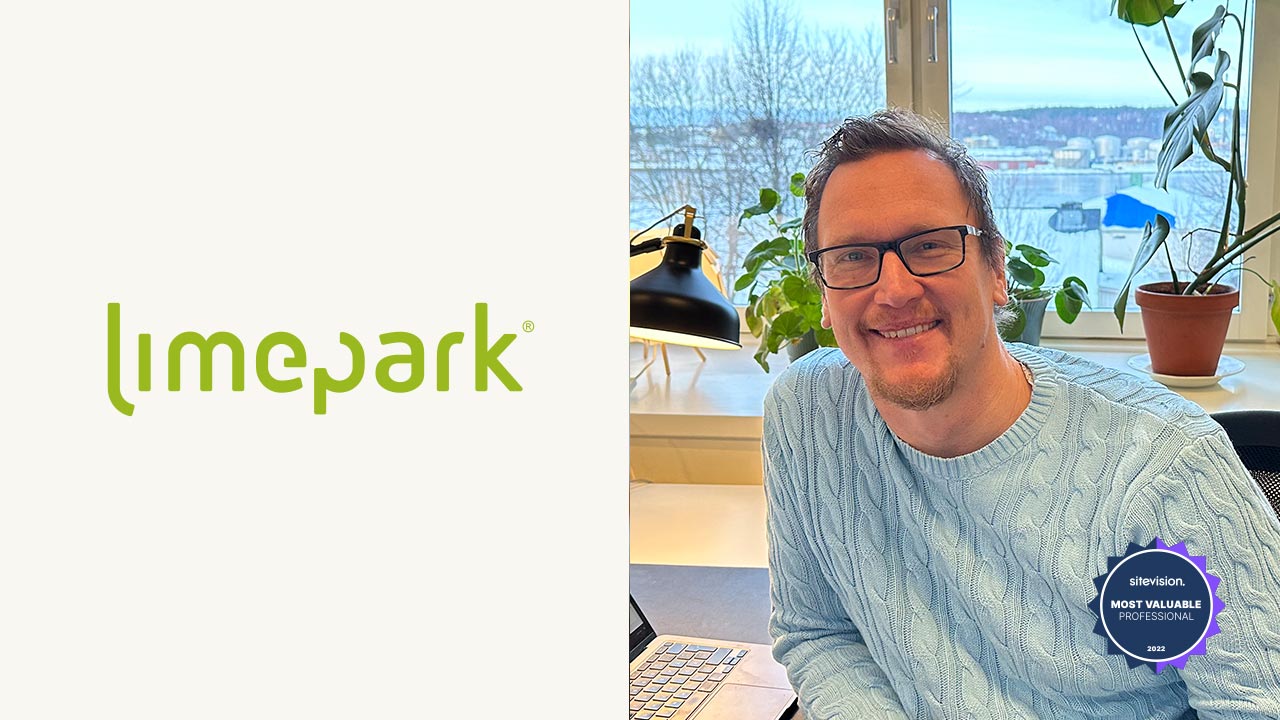Blog
Introducing new customers to Sitevision - the fun and the challenges
During the spring, Sitevision's blog is visited by our Most Valuable Professionals who share their knowledge and expertise. And what's better than sharing? First up is Björn Alexandersson from Limepark who talks about customers who are in the middle of their first Sitevision project. Follow along!

Over the years - and especially recently - Limepark has had the great honour of helping to guide customers new to the Sitevision sphere into Sitevision. I have seen that there are elements in these projects that are different from projects with customers who are Sitevision novices and who know a lot about Sitevision. I thought I would briefly describe the elements and issues that we encounter when working on projects where new customers are implementing a new site in - and at the same time being introduced to - Sitevision.
"This is what we did in the old system. We're used to it and it works well. Can we do the same in Sitevision?"
Can we do what we did before?
This is one of the first questions we come across. Sometimes already at the procurement stage. It's a funny question, because it opens up a lot of discussion. The answer is usually: Yes, you can, but there are probably more cost-effective ways to implement it if we use features built into Sitevision.
To be concrete, I can give the example of Contact Cards. In many other systems, you build a structure or function to display contact information on the website. It becomes a central management of the contact information that can then be used around the site. It is often a function that is developed from scratch with requirements and development hours.
To solve the equivalent in Sitevision, it is of course possible to develop the same functionality again - but Sitevision comes with an extremely large number of small, flexible functions that can be used out of the box.
- Sitevision has a structure for managing contact information in Users.
- Sitevision has the ability to link users to pages through metadata.
- There are a bunch of modules that can utilize users in different ways.
If the client screws with the way they work with something, there are usually very simple ways to solve things that will work over time. The sessions where we have these discussions tend to be very rewarding for both the client and myself - we talk in detail in how Sitevision works and how to work in the platform. Incredibly fun 😊
What level of self-sufficiency do you want?
Everything we do, you can also do with the right training and experience, I usually say. But do you want it? Initially talking about how self-driven the client wants and should be is really important.
If the client wants to be very self-sufficient but won't be working much with the web, we need to use as many standard components as possible and keep the complexity down; if instead the client just wants to work on the content and the editorial piece and get help with development, we'll optimise the delivery for that.
We have clients to whom we deliver a website who then take it and fly it themselves. When we check in with them from time to time, they've launched everything from new web bars to campaigns. They just needed a good start and then do the rest themselves. Then we have clients who get in touch when they want something changed on the site. Depending on how self-sufficient you want to be and how much time and resources you will have at your disposal, there are different delivery paths.
How flexible do you want to work?
During Sitevision Days 2022, both Kungsbacka and Skellefteå talked about their deliveries. We at Limepark delivered to Kungsbacka and Soleil delivered to Skellefteå. They were two completely different deliveries - with two completely different requirements for flexibility.
Watch these two different lectures from the Sitevision days. Both are very good and informative.
Flexibility requires more knowledge. If we take the example of text on a coloured plate:
- Without development
- Requires the editor to know how it works in Sitevision
- Requires the editor to have an eye for design so that there are nice colour combinations
- Requires the editor to know how to test accessibility (e.g. contrasts)
- Through module with own choice of text and colour
- Requires the editor to have an eye for design
- Requires the editor to have knowledge of how to test accessibility (e.g. contrasts)
- Through module with own choice of text and themes
- Requires the editor to be able to formulate good texts
So the difference is how much thought and work has gone into the feature before it is "released".
These are discussions that we and the client need to have on an ongoing basis throughout the project. My experience is that flexible delivery works over time in projects where there are few editors with a lot of time and knowledge. If the client has several editors with varying levels of knowledge, it is best to make as many choices as possible at the development stage - so that the day-to-day work is simplified.
Navigating Sitevision functions
Guiding new Sitevision customers through the functions and solutions available in Sitevision is a lot of fun. There are often at least three ways to solve something, and which one is best depends on the factors I have mentioned above. So I do it with the utmost humility - I need to know how to use and manage it in order to propose a solution that works over time.
This is the point that I like to spend extra time on when I'm a project manager for new Sitevision clients. It's a responsible job to make sure Sitevision lands well in an organisation and great fun to see when the solutions come into use. Whether it's a customer that will fly themselves or a long-term close development project.
Good luck! And do get in touch if you want to bounce something off me 😉
Tags
Share
You must be logged in to submit comments.
Comments are closed for this article
CMS for intranet
Increase engagement and strengthen the workplace culture
with a social intranet.
Quick to get started with ready-to-use templates
Gather strengths – integrate other systems
Secure and Swedish cloud service
Always nearby in the mobile app
User-friendly and web-based interface
CMS for websites
Create engaging websites with a focus on the digital
experience from start to finish.
Personalise more
Web analytics directly in the interface
Accessibility at its finest
Secure and Swedish cloud service
User-friendly and web-based interface







Comments